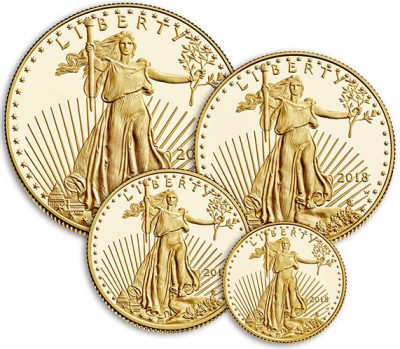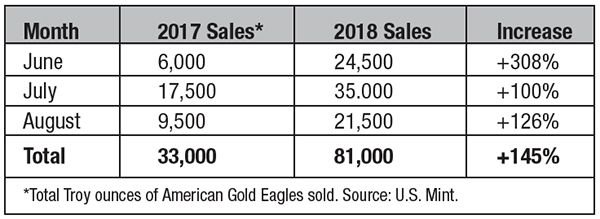
By Mike Fuljenz
Gold maintained its foothold over $1,200 during the last week of August 2018 after touching a low of $1,160 in mid-August. September began with a dip to $1,190 due to a strengthening dollar, but gold bounced back. Traditionally, September is gold’s best month of the year and the stock market’s worst historical month. So it will be interesting to see how our year-to-date numbers change for the final four months of 2018.
American gold Eagle coin sales picked up noticeably over the 2018 summer months at the U.S. Mint. During the first four months of 2018, only 72,000 ounces of American gold Eagle coins were sold, but total gold Eagle sales escalated to 105,000 ounces in the next four months of the year, May to August.
More importantly, sales of American gold Eagles more than doubled in Summer 2018 vs. Summer 2017:

American silver Eagle coin sales also increased in August 2018, even though American silver Eagle sales are down for 2018 as a whole. In August 2018, 1,530,000 one-ounce silver American Eagle coins were sold by the U.S. Mint, almost 50% above the sales of 1,025,000 silver ounces in August 2017.
Lower-Grade Mint State $20 Libs and Saints are a Great Alternative to Bullion at Near “Spot” Prices
It appears that we have finally reached an important turning point in the decline of the shipment of vintage United States gold coins from Europe. When America sold some of its gold to Europe in the early 1900s to settle debts and other obligations, we often sent $20 and $10 gold coins. These coins were easier to count than the smaller gold denominations of the day, such as the $2.50 or $5 Indian gold coins. Most of the coins the Treasury sent to Europe were Saint-Gaudens double eagles ($20 gold pieces) and Liberty Head $20s, as well as $10 Indians and $10 Liberties.
In recent years, lower grade Saint-Gaudens double eagles and Liberty Head $20 gold coins have flooded the U.S. market from Europe to the point where common-date circulated or lower-Mint State gold coins have approached their melt value in some markets. That means fewer dealers are going to Europe, since common-date gold coins are selling too close to melt. There is no premium to be charged. It is not profitable to pay for trips and sort through coins, and it’s not profitable for the European banks to sell them at melt. It’s often easier for everyone to melt these coins than to sell them as rare coins. As a result, a huge amount of these more common-date gold coins have been melted. They have become an alternative to bullion. So you can now buy vintage gold coins at near-bullion prices, a “double play” for both rising bullion prices and added increasing numismatic value.
This meltdown has created a future situation where fewer classic gold coins will be available for new buyers entering the coin market. Generations of new coin buyers will be looking for lower-grade Mint State Saints and Liberties, and these coins won’t be available at near-melt prices. These more common-date gold coins in MS-60 to MS-63 grades should return to their historic numismatic value.
Report from The World’s Fair of Money in Philadelphia
At the World’s Fair of Money, the anniversary convention of the largest coin club in the U.S., the non-profit American Numismatic Association, I am always able to meet with the movers and shakers in our industry, as well as those who run the U.S. Mint and print America’s money. For example, Len Olijar, director of the Treasury Department’s Bureau of Engraving and Printing (BEP), humorously introduced himself by stating: “I make $840 million a day.” He was referring to the amount of paper money he prints each day! I also met the gregarious Director of the Mint, David Ryder, and was encouraged about his efforts to fight counterfeiting of U.S. coins.
I met the former Lead Sculptor of the Mint, Don Everhart. He retired last summer. We had a nice chat about coin designs and his many years at the U.S. Mint. Everhart joined the Mint in 2004 and created designs for numerous coins and medals, notably the award-winning 2014 National Baseball Hall of Fame commemorative coins, designing the reverse and sculpting both sides of the first curved coins produced by the U.S. Mint. He designed and sculpted the common reverse for the Presidential $1 coin and 14 obverse portraits in the series. His designs appear on three of the 50 state quarter coins.
Don began his professional career at the Franklin Mint, where he worked as a sculptor from 1975 to 1980. From 1980 to 2004, he worked as a freelance artist, designing figurines, plates, coins, and medals for Walt Disney, Tiffany, the Royal Norwegian Mint, and the British Royal Mint.
Mike Fuljenz, president of Universal Coin & Bullion in Beaumont, Texas, is a leading coin expert and market analyst whose insightful writing and consumer advocacy have earned major honors from the ANA, PNG, NLG, and the Press Club of Southeast Texas.
Want to receive COINage magazine in your mailbox or inbox? Subscribe today!













